Assisted Living Facilities
* Locations in which residents are permanent with limited mobility or means of other areas of housing
Typical Type of Systems installed
“Wet” Systems for areas inside the building
“Dry” systems for exterior covered porches, porticos or other moisture or temperature sensitive areas
Types of Corrosion Witnessed
Internal Corrosion caused by electro-chemical corrosion and/or a buildup of sludge causing MIC.
External Corrosion is less(but not always) prevalent within a building itself, can be witnessed in such spaces as outdoor rooved areas that are sprinklered
Why testing for corrosion is important
Undetected corrosion can turn into leaks causing mold growth above ceiling panels until leak is detected. This could cause downtime of areas of the facility or depending on how prevalent a total evacuation of the facility
During an “event” undetected corrosion could cause a failure of the system. This failure would potentially require all residents to be relocated to another portion of the building or another facility during entire system replacement. This may not be acceptable or practical.
Testing can provide a mitigation plan for staggered replacement of an aging system reducing the stress on occupants, managers or family members.
Overall system integrity verified instead of assumed during standard testing procedures.
Provides actions to take care of system deficiencies before they become emergencies which can cost significantly more capital due to relocation of residence or violation replacements.

